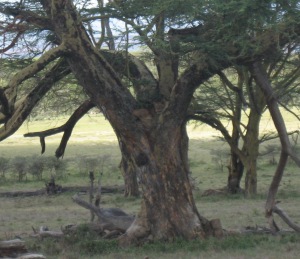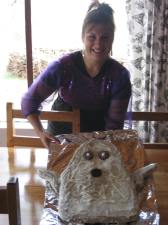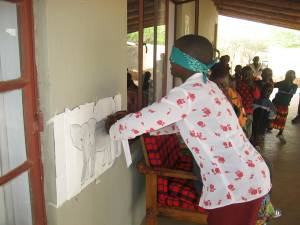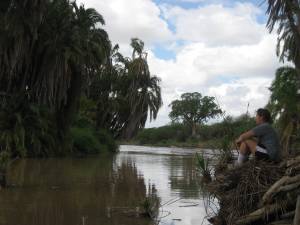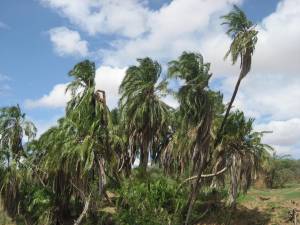Ding! Ding! “Attention, passengers. We have begun our descent and will be landing in the next ten minutes. Please put your trays up and return your seats to their upright position.” Slowly, I blinked my eyes, letting in a small crack of light. With a lurch, the plane dropped then straightened out; unfortunately, the correction in orientation didn’t prevent a wave of nausea from sweeping over me. I closed my eyes again and dozed off. What seemed like seconds later, I was jostled awake by the plane landing on the tarmac… local time: 3:45 a.m. Drowsily, I rose out of my seat and rummaged through the intertwined, searching arms of other passengers and tightly packed luggage in the overhead bins searching for my backpack. Having finally located it, I swung it around onto my back and followed the line of exiting passengers through the narrow aisle.
From this point on, my memory of the week in Egypt seems like a blur of vivd sunset oranges, tropical greens, deep sea blues, and sandy yellows. Instead of giving you a play-by-play of my trip (which would undoubtedly make you yawn and be painful for me to write) I would like to present top and bottom ten lists… Wahoo!
“The Sun God Ra’s Pride & Joy” Egypt Top 10
10. Felluca ride on the Nile – In Luxor also known as Thebes, south of Cairo, the Nile runs straight through the heart of the city. Lining the river are hundreds of Fellucas or small sailboats. They have no engines, just trained sailors. It is a livelihood and most have grown up learning the trade from their fathers, who learned it from their fathers, and so on. I went out on a Felluca around 4:30 pm as the sun was beginning to set… it was the most peaceful part of my trip: the repetitive sound of the water lapping up against the sides of the boat, the warm setting sun’s rays on my face, the peaceful view of farmers on their camels’ backs heading home from the sugar cane fields on the shores, and being served a cup of sweet “welcoming tea” by the captain’s 6-year-old son.

Fellucas on the Nile
9. Muslim mosques & prayers – At the first glimpse of dawn, the speakers would crackle alive and then a recorded deep, mournful voice would reverberate throughout the city. The Adhan, or Muslim call to prayer, was my wakeup call every morning and heard four other times throughout the day. Although some mornings I was roused from a deep slumber (and I certainly wouldn’t be awarded the world’s most cheerful person in the morning award), just hearing the call was exhilarating. It felt as though I was secretly being granted access to experience this ancient and most honored custom… goosebumps raised up on my forearms every time. Meanwhile, lining the streets of Cairo and Luxor were the most ornately decorated and polychromatic mosques. Each mosque had a handful of giant gold-plated, beige, or brightly colored domes and a number of minarets or slim towers rising up to the skies. Every mosque was different, yet uniquely beautiful, and pervaded the chaotic city atmosphere with a sense of tranquility.
8. Egyptian food – pastries, kofta, koshary & guava juice… enough said. The food prices were low and the quality was high. Kofta is a spiced ground beef kabob, often served with rice and a tomato sauce or curry. Koshary seemed like a hodgepodge of ingredients – something a college student might make when cleaning out the pantry. However, don’t turn your nose up at the mixed dish of pasta, rice, lentils, chick peas, onions, garlic and chili sauce…it was delicious!
7. Temple of Queen Hatshepsut – Approaching the Temple is a treat in itself… it’s about a half mile walk to the elevated entrance made up of two giant terraces. You reach the bottom of a wide staircase where you walk up a couple hundred steps to the second terrace’s facade which is alternately decorated with huge pillars and statues of pharoahs. Built entirely of limestone into the side of a cliff, huge rocks menacingly tower over you. Inside the Temple is a funerary obelisk and the tomb entrance… not to mention Queen Hatshepsut kicked ass: as the first female pharoah, she used propoganda and political skills to win over the people of Lower and Upper Egypt. She essentially became “king” by dressing in the traditional garb of male rulers including the headdress and false beard. She also constructed her Temple in the Valley of the Kings which, until her reign, had only held tombs of male pharoahs… to this day she is the only female with a tomb there. Perhaps Queen Elizabeth I took some notes on Hatshepsut’s style…
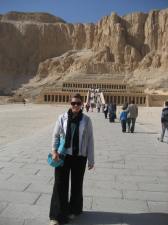
In front of the Temple of Queen Hatshepsut
6. Sugar cane fields lining the Nile – In Luxor, along the banks of the Nile, were miles and miles of sugar cane fields. Incredibly green rows of sweet stalks. In each field a handful of people could be seen working, the occasional child sitting amongst the vast farm land chewing on a freshly snapped off stem, and donkeys mulling about or pulling a load to the farm house. Simply one of the coolest sights.
5. Shopping in the Bazaar & spice market – an attack on every one of your senses: picture every color imaginable penetrating your sight, scents of every origin on earth being inhaled with each breath, continuous shouting from vendors ringing in your ears, the feel of countless silk scarfs and rough beads running through your fingers, and the savory taste of spices, peanuts, and teas being offered to you at every store front. Pretty overwhelming at first, but with time I absorbed it all and ended up having a fun time bargaining for goods. I even accepted a cigarette from a funny little spice vendor-man who kept talking about his cousin in America. It was disgusting (warning, Allison’s strong opinion about to be stated: smoking is bad for you – stop it) but accepting it from him really made his day, so I couldn’t rain on his parade and turn it down.

spice shop in Luxor
4. Valley of the Kings & hieroglyphics – There’s something to be said for entering sacred tombs of Ancient Egypt. Slowly descending from the reflected hot and bright sunlight into the dark coolness of the narrow tunnels leading to the burial rooms of Ancient Pharoahs is unreal. Along the walls were millions of hand-carved hieroglyphics, some still retaining the blues, reds, yellows, and browns that were painted hundreds and hundreds of years ago. Reaching the end of the tomb, were the final burial chambers containing enormous sarcophagi. Ascending once again, you emerge from the tunnel into the blinding light only to be surrounded by the monstrous cliffs and hills of sandstone into which the tombs were carved.
3. Egyptian Museum of Antiquities – You walk into this monstrous building and as far as the eye can see there are artifacts. Both incredibly massive like the full body statues of Ramses II to the minute scarab beetle beads. The museum has so many pieces that some are just haphazardly tossed on the sides of hallways and behind pieces of large construction paper. There is a special room for all of King Tut’s tomb artifacts… the room is kept at a freezing temperature and everything (except the two gold and gem-studded sarcophagi) are behind glass containers. His funerary mask was completely covered in gold, sapphire, rubies, and other precious stones and metals. It felt like you had entered a sacred chamber – everyone walking around and viewing the specimens was speaking in a whisper.
2. Karnak Temple & Luxor Temple – Built during the dynasty of Ramses II, there are hibiscus-shaped pillars as tall as three-story buildings, giant pearly-white obelisks, adorning every possible surface are thousands of carved hieroglyphics telling numerous stories of life, death, and the gods, and huge scarab beetle monuments… all under the open sky. I was lucky enough to visit both sights during the day and at night – each was equally breathtaking. During the day, the sun cast shadows making the sandstone appear alive, and at night the strategically placed lights created an enchanted and ancient mysticism. One trip was not enough…

Luxor Temple at night
1. Giza Pyramids & the Sphinx – Perhaps it was the setting sun behind the Sphinx’s head, or maybe it was reaching such a peaceful place after a chaotic day in the city… whatever the reason, my trip to the Giza Pyramids and the Sphinx was the most memorable. The monuments suddenly rise up from the city’s edge unexpectedly. Within 30 seconds you are transported back in time from the cosmopolitan, busy city center to the days of Ancient Egypt and the powerful worshipping of their many gods. You can actually touch the pyramids… I took a pebble from the ground… shhh! don’t tell. Even for any egocentrist, standing in the Giza Pyramid’s shadow will make you realize just how small you really are.

the Sphinx, the Pyramid, & Allison
honorable mention: Welcoming Tea – often given to you when you entered a store. It is made from dried hibiscus petals and sugar; Egyptian music – really funky and different than most stuff I listen to… I regret not getting a CD.
“What Makes King Tut Roll Over in His Grave” Egypt Bottom Ten
10. Titanic song “My Heart Will Go On” – for some reason, everyone had this song as their cell ringtone. Not only that, but it was playing in every taxi, elevator, and store I stepped into. BRUTAL. Thank you Celine Dion.
9. Nescafe – Coffee grounds… what’s that? On every menu under the “beverages” category I would scroll down and desperately hope to see ‘coffee.’ Instead, every time I was met with disappointment as my eyes fell upon ‘Nescafe’ right after the tea selections. Instant coffee is the drink of choice in Egypt and as an avid coffee drinker, Nescafe did not get the job done.
8. Sad-looking donkeys – there were so many donkeys on the streets of Luxor and the suburbs of Cairo… and they all looked SO sad pulling their carts packed high with sugar cane. I kept thinking about the bad boys in Pinocchio who travel to the island and get turned into donkeys… it made me sad.
7. Pollution – forget about a decent sunrise or sunset in Cairo. The air is so thick with smog that all you can see is a yellowish-orange haze. I also felt like I had a thick layer of grime on me and needed to shower after every venture onto the streets.
6. Number of other tourists – I guess it’s a good thing for Egypt, but MAN! Sometimes it really took away from the atmosphere that the ancient sights offered. Most of my pictures also have some lumbering idiot wearing a Hawaiian shirt and binoculars squinting up at a statue… harsh? Probably, but it got pretty frustrating at some moments.

really?!
5. Cigarette smoking – Perhaps Egypt has not heard that smoking kills you because everyone, everyone, smokes. It especially got to me when for a five-minute drive, my taxi driver couldn’t fight the urge to light up. Even in restaurants, chances were that the couple sitting next to me would start smoking as soon as their wine was served.
4. Hassle by store & sight vendors – In every store you passed by, the vendor would shout at you and on most occasions, run up to you shoving whatever their item was in your face. With so much competiton I guess they need to do it, but their aggressiveness was usually so overwhelming that I didn’t even want to look at whatever they were selling. Even at the sights, like the Temples, there were vendors INSIDE bothering you and trying to sell crappy carved scarab beetles and bootlegged dvds. It really urked me when I was trying to enjoy the feel of the place.
3. Ripped off by taxi drivers – Not knowing Arabic was an obvious sign that I was a foreigner and the taxi drivers abused that like no other. For short distances they started off by charging insane amounts. After a few outrageously priced taxi rides, I became tougher and bargained harder but I was still ripped off.
2. Overnight train to Luxor and back to Cairo – One word: freezing. For some reason, the heat didn’t work on the trains and the temperature of the cabins must have dropped to below freezing temperatures. We could actually see our breath and the windows frosted over. Needless to say, the shivering and constant movement to keep my blood flowing prevented any sleep from occuring.
1. Catcalling – By far the most annoying part of the trip was the attention that every single Egyptian male pays to foreign females. It was insane. From marriage proposals to “Wow, your eyes are so beautiful” to hissing across entire boulevards, the calls were incessant. By the end of my trip, I think I appreciated the quiet the most.
Seeing as I finished on a sour note with the bottom ten, I’d like to say that the overall trip was incredible. I’d like to go back after I visit a few other places. Yet, as I landed back in Nairobi and arrived at Mpala several hours later, I felt so content and comfortable curled up in my bed. It felt good to be home.



















